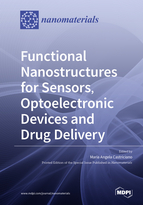Functional Nanostructures for Sensors, Optoelectronic Devices and Drug Delivery
A special issue of Nanomaterials (ISSN 2079-4991).
Deadline for manuscript submissions: closed (30 September 2019) | Viewed by 73531
Special Issue Editor
Interests: nanomaterials; supramolecular chemistry; self-assembly; porphyrins; expression and transmission of chirality at nano and mesoscopic scale; spectroscopy
Special Issues, Collections and Topics in MDPI journals
Special Issue Information
Dear Colleagues,
Nanoparticles and nanostructured materials, due to their tunable physicochemical properties and their enhanced performance with respect to the corresponding bulk counterparts, represent an active area of research for their impact in many application fields. Recent progress in the synthesis of nanomaterials and the fundamental understanding of their properties has led to significant advances in nanomaterial-based sensors, in optoelectronic devices, and in drug delivery systems.
For these applications, it is essential to design and synthesize novel systems with an optimized structure and properties, a goal which has been achieved using nonconventional approaches. In this respect, nanostructured materials with peculiar optical properties are attracting increasing interest since their optical response, in terms of electronic absorption, emission fluorescence, optical activity, photocurrent, and so on, can be largely influenced by slight changes in the microenvironments and in the presence of specific analytes. These peculiar features can be conveniently exploited in a variety of different applications.
This Special Issue welcomes the submission of original research papers or comprehensive reviews that demonstrate or summarize significant advances in the synthesis and application of novel functional nanostructures, with potential applications in sensor, optoelectronic devices, and/or drug delivery.
Dr. Maria Angela Castriciano
Guest Editor
Manuscript Submission Information
Manuscripts should be submitted online at www.mdpi.com by registering and logging in to this website. Once you are registered, click here to go to the submission form. Manuscripts can be submitted until the deadline. All submissions that pass pre-check are peer-reviewed. Accepted papers will be published continuously in the journal (as soon as accepted) and will be listed together on the special issue website. Research articles, review articles as well as short communications are invited. For planned papers, a title and short abstract (about 100 words) can be sent to the Editorial Office for announcement on this website.
Submitted manuscripts should not have been published previously, nor be under consideration for publication elsewhere (except conference proceedings papers). All manuscripts are thoroughly refereed through a single-blind peer-review process. A guide for authors and other relevant information for submission of manuscripts is available on the Instructions for Authors page. Nanomaterials is an international peer-reviewed open access semimonthly journal published by MDPI.
Please visit the Instructions for Authors page before submitting a manuscript. The Article Processing Charge (APC) for publication in this open access journal is 2900 CHF (Swiss Francs). Submitted papers should be well formatted and use good English. Authors may use MDPI's English editing service prior to publication or during author revisions.
Keywords
- nanomaterials
- aggregation phenomena
- supramolecular chemistry
- chromophoric systems
- metal nanoparticles
- quantum dots







